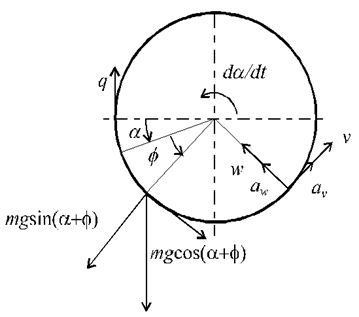The rotating shell of mean radius r is shown in Figure 1. Here, m denotes unit mass, g - gravity acceleration and t - time. The rotation angle of shell is denoted as α, the longitudinal and the angular co-ordinates of shell elements are denoted as x and φ. The longitudinal, circumferential and radial components of the shell surface deflection are denoted as u, v and w respectively.

Figure 1 The rotating shell.
The components of the acceleration of the shell element have the form
(1)
Taking into account the inertia, damping and gravity forces, the loading of an element can be written as
(2)
Here, (c1, c1, c1) are coefficients of damping. The internal forces are assumed to be of the form
(3)
The internal torque is
(4)
The integration over entire length L of the shell gives the driving torque Ms. The angular acceleration is found as
(5)
The components of the shell surface deflection can be expressed in the form
(6)
Where
(7)
(8)
(9)
For n=1,2,3,...nmax, N=1,2,3,...Nmax.
Substituting (6-9) into equation (5) and carrying out the integration (5), one obtains
,
.(10)
The partial differential equations governing the motion of shell element will now be replaced by ordinary differential equations using Ritz-Galerkin. Let’s pre-multiply those equations4,5 by the transposition of functions (8) and then integrate of the resultant expressions by parts with the use of the forces-displacement relationships and boundary conditions
,
,
. (11)
As a result of the integration, we obtain a set of three ordinary differential equations of second order
,
(12)
Introducing matrices of three times higher order, than the matrices in equations (12), these set can be rewritten as one equation
(13)
Where T=[Tu,Tv,Tw].
Adding now equation governing the driving torque of the motor
(14)
We obtained the set of three equations (10,13,14) from which angle of drum rotation α, components of elastic deflection T (7-9)and driving torque Ms can be found through numerical integration. Similar calculations were performed by the author for a spindle directly driven by three-phase electric motor.14


